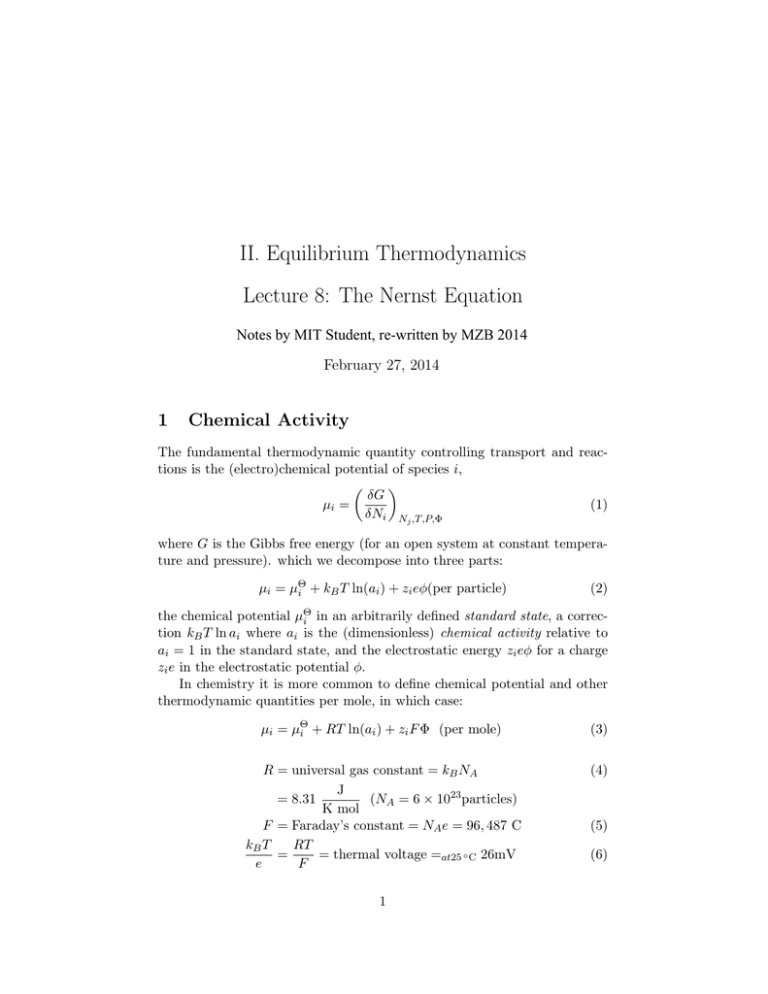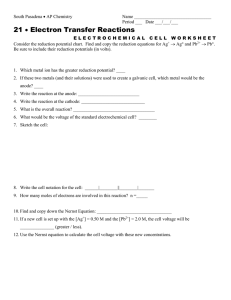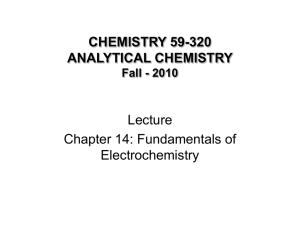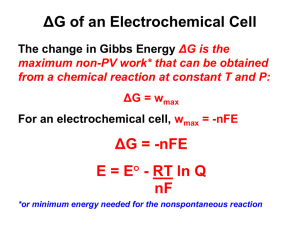II. Equilibrium Thermodynamics Lecture 8: The Nernst Equation
advertisement

II. Equilibrium Thermodynamics Lecture 8: The Nernst Equation Notes by MIT Student, re-written by MZB 2014 February 27, 2014 1 Chemical Activity The fundamental thermodynamic quantity controlling transport and reac­ tions is the (electro)chemical potential of species i, µi = δG δNi (1) Nj ,T,P,Φ where G is the Gibbs free energy (for an open system at constant tempera­ ture and pressure). which we decompose into three parts: µi = µΘ i + kB T ln(ai ) + zi eφ(per particle) (2) the chemical potential µΘ i in an arbitrarily defined standard state, a correc­ tion kB T ln ai where ai is the (dimensionless) chemical activity relative to ai = 1 in the standard state, and the electrostatic energy zi eφ for a charge zi e in the electrostatic potential φ. In chemistry it is more common to define chemical potential and other thermodynamic quantities per mole, in which case: µi = µΘ i + RT ln(ai ) + zi F Φ (per mole) (3) R = universal gas constant = kB NA J = 8.31 (NA = 6 × 1023 particles) K mol F = Faraday’s constant = NA e = 96, 487 C kB T RT = = thermal voltage =at25 ◦ C 26mV e F (4) 1 (5) (6) Lecture 8: Nernst equation 10.626 (2014) Bazant Since we focus on microscopic mechanisms, however, we will typically de­ fine all thermodynamic properties per particle (which is more common in physics). As shown in the example below, in the limit of an infinitely dilute so­ lution, the activity is proportional to the concentration. In a non-dilute “concentrated solution” where particles interact with each other, there are corrections related to all other contributions to the chemical potential, such as short-range forces between molecules (contributing to enthalpy h) or temperature-dependent crowding effects (contributing to the entropy). These non-ideal contributions to the chemical potential can be expressed via an activity coefficient γi , whose precise definition depends on the way of mea­ suring concentration (per volume, per mass, per site, etc.) and is typically scaled such that γi = 1 in the standard state of a single species (in a dilute solution): ai = γic c̃i = γim m̃i = γix xi = γip pi = . . . (7) where c̃i = ci /cref is the dimensionless species concentration with cref = 1M = 1 mole/liter = 1 molar, m̃i = mi /mref is the dimensionless molality in solution with mref = 1 mol/kg solvent = 1 molal, xi = Ni /Nsite is the mole fraction or filling fraction of available solid sites (dimensionless), p̃i = pi /pref is the dimensionless gas partial pressure with pref = 1 atm, etc. Example: Lattice gas, or ideal solid solution. In the previous lecture, we used statistical mechanics to derive an explicit expression for the chemical potential of an ideal solid solution (or lattice gas) of non-interacting particles on a lattice: µ = kB T ln x = kB T ln(γx) 1−x (8) which comes from the Gibbs free energy of mixing (only entropy). In this case, we have 1 γ= (9) 1−x The activity coefficient goes to infinity as x → 1 due to crowding effects (reduced entropy of vacancies in the lattice). Increased activity means larger chemical potential, and thus greater tendency to have reactions or transport that lower the concentration by removing particles. At the simplest level, this is what stops battery discharge when a reactant is fully consumed. Later we will apply this model to Li-ion batteries. • 2 Lecture 8: Nernst equation 10.626 (2014) Bazant φe +z i electrode (usually metal) 2 electrolyte "half cell" Faradaic reactions in equilibrium Any Faradaic “half-cell” charge-transfer reaction at an electrode can be ex­ pressed in the following standard form, producing n electrons: si Mizi → ne− (10) i where si = stoichiometric coefficients (11) Mi = chemical symbols (12) zi = charge numbers (13) n = number of electrons transferred (14) Charge conservation requires si zi = −n (15) i The forward direction of the Faradaic reaction represents oxidation, or increase of the charge state of the molecules (on the left hand side) while liberating electrons. In a galvanic cell, electrons flow spontaneously from the anode to the cathode, so the forward direction of the reaction is also called the anodic reaction. At the anode, si > 0 for reactants, and si < 0 for products, while the signs are reversed for a cathodic reaction which consumes electrodes and leads to reduction of the charge state of the molecules. For example, the hydrogen oxidation reaction can be written as H2 − 2H + → 2e− (sH2 = 1, sH + = −2, zH + = 1, n = 2) The Faradaic reaction can also be written with only positive coefficients as R= si Mizi → |si |Mizi + ne− = O + ne− (16) si >0 si <0 3 Lecture 8: Nernst equation 10.626 (2014) Bazant φe electrode$$|$$solu/on$ φ (a)$ zOe O (e) O (szOs) ne − z R(e)Re (b)$ zRs R (s) O zO ne − R zR (c)$ O zO ne − R zR Figure 1: Types of Faradaic reactions O + ne− → R. (a) General mixed ion-electron conductor electrode/electrolyte interface. (b) Redox in solution. (c) Ion intercalation or electrodeposition. where R is the “reduced state” and O is the ”oxidized state”. The figure shows different Faradaic reactions at an electrode/electrolyte interface. Let us assume that ions only exist in the electrolyte (neglecting mixed ion-electron conductors). For redox reactions (1(b)), e.g. Fe3+ +e− → Fe2+ , the reduced state is in the solution at the same potential, φR = φO = φ. For electrodeposition (1(c)), e.g. Cu2+ + 2e− → Cu, or ion intercalation as a neutral polaron (ion/electron pair), e.g. CoO2 +Li+ + e− → LiCoO2 , the reduced state is uncharged, zR = 0, so we can also set φR = φ, even though it is in the electrode. For this broad class of Faradaic reactions, we can thus let φ be the electrostatic potential of each ion, and φe be the potential of the electrons in the electrode. The Nernst potential or interfacial voltage drop (electrode minus elec­ trolyte) is the Δφ = φe − φ (17) and we will now derive its value in equilibrium. The total electrochemical potential of each side of the reaction must be 4 Lecture 8: Nernst equation 10.626 (2014) Bazant equal in equilibrium, X si µi = nµe (18) i where the electrochemical potential of the electron µe is the Fermi energy of the highest occupied electronic quantum state. Inserting the definitions above, µi = µΘ i + kB T ln ai + zi eφ µΘ e µe = + kB T ln ae − eφe (19) (20) and using charge conservation X si zi = −n (21) i we arrive at the Nernst equation: kB T Δφ = Δφ − ln ne 0 where ΔφΘ = µΘ e − si i ai ane _ (22) Θ i si µi (23) ne is the standard potential, or interfacial voltage when all reactants are in their standard states. The Nernst equation shows how the interfacial voltage of the half-cell reaction varies with reactant activities away from the standard state. We can also write Δφ = ΔφΘ + kB T aO ane ln ne aR where si >0 3 |si | asi i , aO = aR = ai (24) (25) si <0 Redox Equilibrium Constants For a general chemical reaction, the equilibrium constant K is the ratio of the activities of the products to those of the reactants, in chemical equilib­ rium. If K > 1 (or K < 1), the forward (or backward) reaction is ther­ modynamically favored under standard conditions and leads to more (or 5 Lecture 8: Nernst equation 10.626 (2014) Bazant less) products compared to reactants. In the case of the general oxidation reaction, R → O + ne− , the equilibrium constant is −1 Kox = Kred = aO ane aR (26) whose inverse Kred is for the backward reduction reaction. (The term redox is used to refer to reversible charge transfer reactions, and combinations of oxidation and reduction half reactions are called redox couples.) The physical significance of the Nernst equation becomes more clear in terms of the redox equilibrium constants, ne(∆φeq − ∆φΘ ) −1 (27) Kox = Kred = exp kB T Now we see that by increasing the Nernst equilibrium potential, Δφeq , we increase Kox so as to favor the forward oxidation reaction that produces electrons. This makes sense because electrons are drawn to the more positive potential of the electrode as its voltage relative to the solution is increased. The opposite trend holds for the standard Nernst potential. If we in­ crease ΔφΘ , then Kox decreases so as to favor the reduction reaction that consumes electrons. In galvanic cells, therefore, half-cell Faradaic reactions with larger ΔφΘ act as cathodes (consuming electrons) when coupled with those having smaller ΔφΘ , which act as anodes (producing electrons). 4 Standard Cell Potential In order to measure the potential of an electrode φe , we must form a complete electrochemical cell with two electrodes, and two half-cell Faradaic reactions, since only differences in potential are well defined. As such, the standard cell potential, E Θ = ΔφΘ − ΔφΘ (28) ref = φe − φref is defined relative to a standard reference electrode. An electrode reaction with E Θ < 0 acts as an anode (negative battery terminal, producing elec­ trons), and one with E Θ > 0 as the cathode (positive terminal, consuming electrons), when coupled to the standard reference electrode. Comment on notation: In electrochemistry, it is common to denote cell voltage (potential difference) with E to denote “electro-motive force” or “emf”. This can cause confusion with the electric field amplitude, also de­ noted E (in all fields of science), which is the local gradient of the potential! 6 Lecture 8: Nernst equation 10.626 (2014) Bazant Faradaic reactions in aqueous electrolytes − Limetal → Li+ (aq) + e 2− P b + SO4 → P bSO4 + 2e− H2 → 2H + − 2e− 2H2 O → O2 + 4H + + 4e− P bSO4 + 2H2 O → P bO2 + SO42− + 4H + + 2e− E Θ (V) -3.045 -0.356 0 1.229 1.685 E = Vφ To avoid confusion, we use φ to denote the electrostatic potential, E for the electric field, Δφ for potential differences (e.g. across interfaces), V for cell voltage (Δφ between two electrodes), and V Θ for its reference value under standard conditions. However, for consistency with electrochemistry tables, we use E Θ for the standard cell potential, relative to a given refer­ ence. For aqueous electrolytes, the usual reference electrode is the “standard (or normal) hydrogen electrode” (SHE), which consists of H2 gas at 1 atm partial pressure at room temperature undergoing fast, reversible oxidation, typically at a platinum electrode, in acidic solution (aH + = 1, pH=0). As shown in the figure, one can measure the potential of another electrode relative to SHE by preparing two aqueous solutions connected by a lowresistance salt bridge, which allows ions to pass and equilibrate across the two chambers, while a very small current is drawn to measure the open cir­ cuit voltage of the cell. If the test system is at standard conditions (1atm, 25 ◦ C) then we write E Θ = standard cell potential relative to SHE. Some examples are shown in the table: lithium oxidation, lead-acid battery reac­ tions, and water electrolysis. 5 Open Circuit Voltage In equilibrium, the open circuit voltage (OCV) of a two-electrode electro­ chemical cell can be obtained as the difference of the two half-cell voltages. Under standard conditions, this is just given by the difference of standard potentials, which can be looked up in a table or measured experimentally. For example, we can create a galvanic cell with lithium metal oxidation (electro-dissolution) occurring at the anode, and oxygen gas reduction to produce water at the cathode, as shown in the figure. The open circuit voltage under standard conditions would be VO = 1.229 − (−3.045) = 4.3V . 7 Lecture 8: Nernst equation 10.626 (2014) Bazant PEM Li O2 + H water + Li H2O More generally, we use the Nernst equation to describe how the OCV changes with the activities of the reactants away from standard conditions. The cell voltage is generally the difference V = φ c − φa (29) between the potentials of the cathode and anode, or the positive and negative terminals, respectively, in the case of a galvanic cell. Under open circuit conditions in equilibrium, the electrolyte potential is constant, so we can write VO = Δφc − Δφa (30) and use the Nernst equation, kT VO = V Θ + ln ne _ j _ s aj j (anode reaction) si i ai (cathode reaction) (31) where the standard OCV with all reactants in the standard states is Θ Θ Θ V Θ = ΔφΘ c − Δφa = Ec − Ea (32) By charge conservation, net cell reaction involves only neutral reactants and products, so we can also write the OCV as kT acell reactants Θ VO = V + ln (33) ne acell products If we write out the redox reactions, (anode half cell) Ra → Oa + ne− Oc + ne− → Rc (cathode half cell) Ra + Oc → Oa + Rc (full cell) then VO = V Θ + kT a R aO ln a c ne aOa aRc 8 (34) (35) Lecture 8: Nernst equation 6 10.626 (2014) Bazant Cell Equilibrium Constant a products The equilibrium constant of the net cell reaction, K = areactants , is measured under short circuit conditions at equilibrium, VO = 0, when there is no spontaneous current flow, and thus no chemical driving force between the anode and the cathode. The Nernst equation relates the cell equilibrium constant to the standard cell voltage, K = eneV Θ /kT = a Kox c Kred (36) which is also related to the ratio of redox equilibrium constants of the two electrodes. Because this value can be very large or small, it is convenient to refer to the “pK” value defined by pK = − log10 K = − nV˜ Θ log10 e (37) although since the historical convention is to use base ten, we must keep track of the factor (log10 e)−1 = 2.302. From the definition of cell voltage as the Gibbs free energy change of the system per charge passing through the external circuit, V = ΔG/(−ne), we also recover the fundamental relation K = e−ΔG Θ /kT (38) where ΔGΘ is the free energy of reaction (of products minus reactants) for the net cell reaction under standard conditions. Example: Short-circuited hydrogen-oxygen fuel cell. The net reaction is water production: H2 + O2 → H2 O. V Θ = 1.229V (39) n=2 kB T = 26mV (room temperature) e ∴ K ≈ e94.5 = 1.0 × 1041 » 1, −pK = 41 » 1 (40) (41) (42) We see that with only one volt standard potential, the equilibrium con­ stant is astronomically large, almost as large as Avogadro’s number squared (NA = 6.022 × 1023 particles per mole), implying that essentially every sin­ gle molecule of H2 and O2 is converted to H2 O in equilibrium, if no other 9 Lecture 8: Nernst equation 10.626 (2014) Bazant reactions or kinetic limitations can occur. This is the typical situation when an electrochemical cell is short-circuited. Because Faradaic reactions involve breaking and reforming stable chemical bonds (which are not destroyed by thermal fluctuations), the free energy of reaction is usually much larger than the thermal voltage, leading to a very large equilibrium constant for the net reaction. Away from short circuit conditions, the OCV can be expressed in terms of the cell equilibrium constant, VO = kT Kareactants ln ne aproducts (43) or in terms of the redox equilibrium constants, VO = kT K a aR aO ln cox a c ne Kred aOa aRc where it is clear that VO = 0 in equilibrium. 10 (44) MIT OpenCourseWare http://ocw.mit.edu 10.626 Electrochemical Energy Systems Spring 2014 For information about citing these materials or our Terms of Use, visit: http://ocw.mit.edu/terms.








